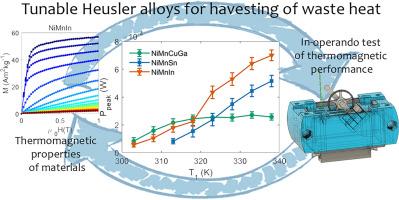用于热磁收集低品位废热的可调谐Heusler合金的运行试验
IF 9.3
1区 材料科学
Q1 MATERIALS SCIENCE, MULTIDISCIPLINARY
引用次数: 0
摘要
热磁发电是一种很有前途的技术,用于收集和转化100°C以下的低品位废热。尽管在过去的十年里,热磁材料和原型的研究呈指数级增长,但为了释放这项技术的全部潜力,材料的基础研究和先进设备的设计之间仍然存在着巨大的差距。在这项研究中,我们对三种具有代表性的Ni, mn基Heusler合金进行了热磁性能的在职评估,这些合金被优化用于收集低于373 K的低品位废热。这些材料在操作条件下使用专门设计的实验室规模的热磁电机原型进行了测试。NiMnIn、NiMnSn和NiMnCuGa合金驱动电机的机械功率输出与材料的磁性能相关,突出了磁转变温度和饱和磁化在决定热磁能转换效率中的关键作用。由于奥氏体Heusler合金的居里温度可调,且在300-360 K温度范围内磁化强度变化显著,因此被证实是一种很有前途的热磁材料。在测试材料中,Ni48Mn36In16合金表现出最高的热磁性能,在320-340 K范围内超过基准材料Gd。从实验角度来看,所研制的热磁电机样机可以作为一个灵活的试验台,用于评估和比较少量(小于0.3 g)新材料在可变条件下的热磁性能。此外,其模块化设计便于测试和优化其各种组件,从而有助于热磁电机技术的进步。本文章由计算机程序翻译,如有差异,请以英文原文为准。


In-operando test of tunable Heusler alloys for thermomagnetic harvesting of low-grade waste heat
Thermomagnetic generation stands out as a promising technology for harvesting and converting low-grade waste heat below 100°C. Despite the exponential growth in research on thermomagnetic materials and prototypes over the last decade, there remains, to unlock the full potential of this technology, a critical gap between fundamental research on materials and the design of advanced devices.
In this study, we present the in-operando assessment of thermomagnetic performance of three representative Ni,Mn-based Heusler alloys optimized for harvesting low-grade waste heat below 373 K. These materials were tested under operational conditions using a specially designed laboratory-scale prototype of a thermomagnetic motor. The mechanical power output of the motor, operated with NiMnIn, NiMnSn and NiMnCuGa alloys, was correlated with the magnetic properties of the materials, highlighting the critical role of the magnetic transition temperature and saturation magnetization in determining the efficiency of thermomagnetic energy conversion. Austenitic Heusler alloys were confirmed to be promising thermomagnetic materials due to their highly tunable Curie temperature and significant magnetization changes in the 300–360 K temperature range. Among the tested materials, the Ni48Mn36In16 alloy demonstrated the highest thermomagnetic performance, surpassing the benchmark material Gd in the 320–340 K range. From an experimental perspective, the developed prototype of thermomagnetic motor serves as a flexible test-bench for evaluating and comparing the thermomagnetic performance of small amounts (less than 0.3 g) of new materials under variable conditions. Additionally, its modular design facilitates testing and optimization of its various components, thereby contributing to the advancement of thermomagnetic motor technology.
求助全文
通过发布文献求助,成功后即可免费获取论文全文。
去求助
来源期刊

Acta Materialia
工程技术-材料科学:综合
CiteScore
16.10
自引率
8.50%
发文量
801
审稿时长
53 days
期刊介绍:
Acta Materialia serves as a platform for publishing full-length, original papers and commissioned overviews that contribute to a profound understanding of the correlation between the processing, structure, and properties of inorganic materials. The journal seeks papers with high impact potential or those that significantly propel the field forward. The scope includes the atomic and molecular arrangements, chemical and electronic structures, and microstructure of materials, focusing on their mechanical or functional behavior across all length scales, including nanostructures.
 求助内容:
求助内容: 应助结果提醒方式:
应助结果提醒方式:


